Original URL: https://www.theregister.com/2013/02/07/seagate_wireless_plus_hard_drive_review/
Review: Seagate Wireless Plus Wi-Fi hard drive
A terabyte of portable storage for your Android or iOS device
Posted in Personal Tech, 7th February 2013 12:19 GMT
In the week Apple finally released an iPad with a storage capacity greater than 64GB - double that; 128GB to be precise - Seagate made its Wireless Plus available. Of course, if Apple’s Flash mark-up wasn’t so colossal, or it had had the wit to either built a Micro SD port into its tablets or allow USB mass storage devices to connect to the dock connector, Seagate wouldn’t have had to bother. Fortunately for space-starved iDevice owners - or those for whom the $799 (£506) price tag is too high - here’s an extra terabyte of storage for 170 quid.
And not just iOS fans. Wireless Plus, an external hard drive with a Wi-Fi adaptor, basic router and a battery to keep it all running, can also provide extra capacity for folk with Android tablets.
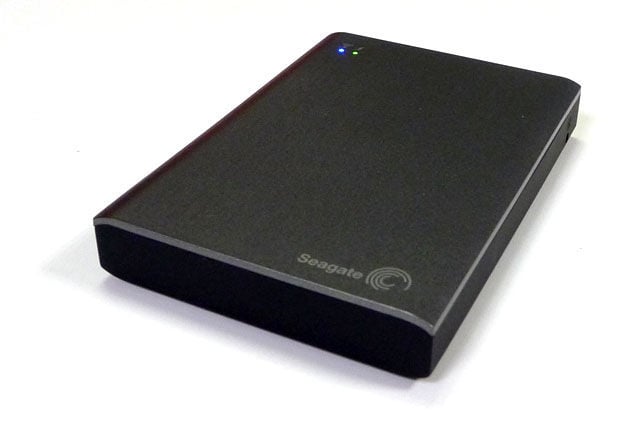
Seagate Wireless Plus: not bad looking - and solid too
This is Seagate’s second such product. The first, the GoFlex Satellite, debuted a couple of years back. Its successor is an altogether more polished offering. It’s really the 2.0 product to the GoFlex Satellite’s 1.0, rather than just a redesign of the drive casing. Seagate has revised the system to eliminate most but not all of the first release’s issues, and if it’s not quite perfect, it is nonetheless considerably more usable than it was before.
A case in point: the GoFlex Satellite comes formatted with an NTFS drive. That’s fine if you’re a Windows users, but Mac types, with native NTFS reading in their favoured OS but not writing, needed to install a third-party NTFS driver. That was no big deal - Seagate provided one for free. A better solution, surely, would be to allow Mac users to format the drive to an OS X-friendly HFS+ volume. Now, using a bundled utility, they can, and back again if they need to.
Perhaps a better solution still would be simply to ship the thing formatted to Fat 32 for broad OS compatibility. Of course, Fat 32 doesn’t support files larger than 4GB, but a more ecumenical approach to the drive’s file system would still allow user for whom this is a problem - there can’t be many, since H.264 will compress even 1080p HD movies down to well under 4GB - to pick a more appropriate file system. Well, here’s hoping for version 3.0...
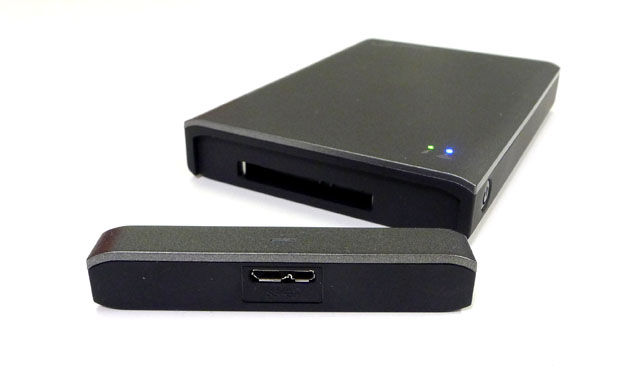
The USB 3.0 port comes off, to be covered over or replaced with a different connector
It doesn’t seem likely, though, that a future release will be easier to get into than the Wireless Plus. The GoFlex Satellite was hard enough to crack open, as anyone who, like me, thought it might make a good housing for a more travel resilient storage type than HDD. The new version is harder still.
You know why? It’s that pesky consumerisation thing. It’s aimed primarily at non-techies, and Seagate - and it’s not the only manufacturer that does this, not by a long chalk - seems to think techies will look elsewhere. So, no leeway is granted to users who might want to swap out the HDD for a smaller but more resilient SSD, or for a bigger 2.5-inch hard drive when they become available at the right price.
The software is likewise geared to the un-geeky. The Wireless Plus works with Seagate’s own Seagate Media app, which provides a rudimentary, media-specific file finding experience. Content is automatically organised into Music, Movies and Photos folders with everything else herded into a catch-all Documents listing. This is simply how the files are presented by the app; you can organise your files on the drive how you like. The app has a folder/file listing view too.
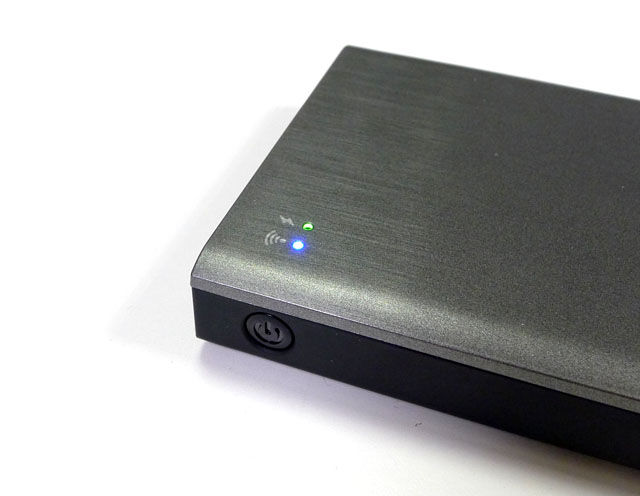
The power button needs only a light touch to trigger
Fortunately, the new app is rather smarter than its predecessor, which threw its hands up and sighed went presented with a file it didn’t know what to do with. Now the app taps the OS to see if there’s a program present that can handle, say, .CBZ files, say, that the OS’ native file viewers and Seagate Media can handle.
On iOS, these ‘non-native’ files are downloaded to the app’s local, sandboxed storage and can them be transferred - one at a time, but that’s yet another of iOS' bizarre limitations - to a suitable viewer app if one has been installed. There’s an inconsistency: some files are downloaded for app-to-app transfer immediately, others aren’t. What separates the second group of files from the first is that Seagate Media recognises them as media files. So .PDFs and .CBZs, say, are ‘expected’ to be opened into another app and so when tapped auto-download and pop up the ‘which app do you want to open this with?’ dialog. Seagate Media can’t present AVIs any more than it can present PDFs, but rather than follow the same procedure, it simply tells you the file is incompatible. The app knows the AVI is a media file and displays it as such, even though it can't actually play it. To transfer and play the file, you have to download it manually and then tap on the downloaded file to trigger the app selection dialog.
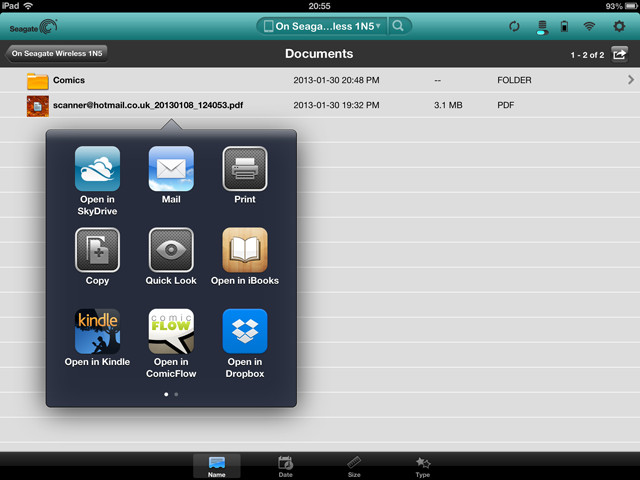
Seagate Media can't display PDFs itself, so it suggests apps you might use instead...
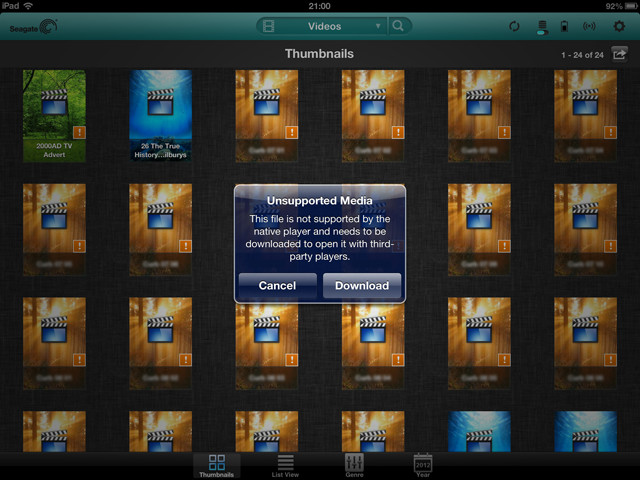
It can't play AVIs, either, but here it offers no easy choice up front
I understand why Seagate Media does this - users might not want to download big video files, while they probably won't care about small documents - but it makes for a disjointed experience. To be fair, it's also as much iOS' fault as Seagate's.
File-association football
Android isn’t a great deal better. Tap the AVI and it’ll automatically start playing in a suitable media app if you have one. On my Nexus 7 I have VPlayer, and Seagate Media hands it any AVI I tapped on - it plays H.264 files natively. I also have Perfect Viewer installed, but Seagate Media would only tell me it didn’t know how to handle CBZs. At least I could manually download the files and open them from within Perfect Viewer. An Android bug, a Seagate Media error or an issue with Perfect Viewer? Whatever, it makes for a less than satisfactory experience.
Incidentally, there’s a version of Seagate Media for the Amazon Kindle Fire too, which I couldn’t test, and Seagate is promising to release a version for 2012 and newer Samsung Smart TVs.
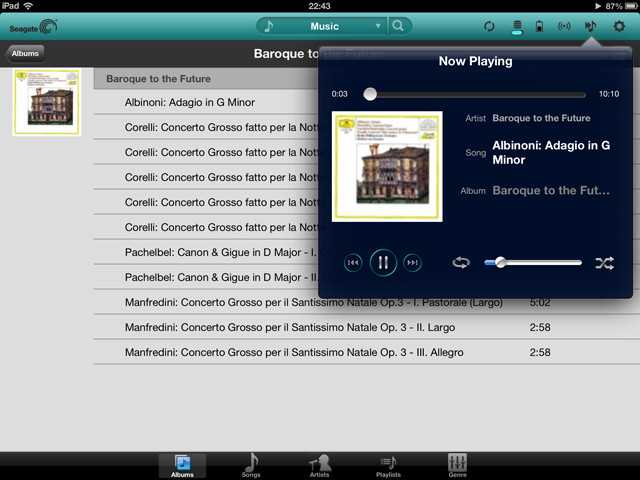
iTunes metadata is supported
Fortunately, the Wireless Plus server software supports SMB/CIFS so it’s easy to tap its storage through any app or operating system that supports these protocols, which is not only handy for uploading files as well as downloading them, but gives the Wireless Plus some Linux friendliness. “Linux is not supported by Seagate... When connecting via USB, the drive may go to sleep and cause errors if Linux does not wait for it to wake up. There is no tool available to disable the sleep feature under Linux,” the manual says.
But, then, the Wireless Plus’ role is to be a media server not a file server. It has a DLNA (uncertified) server on board, and supports Apple’s AirPlay to stream movies and music through an Apple TV.
The unit itself is a robustly constructed 127 x 89 x 20mm, 256g piece of work that’s more solid-feeling - and better looking - than the GoFlex Satellite. It’s a little more compact but it uses the same Sata-based GoFlex clip-on adaptor system. Seagate bundles a USB 3.0 module, but you can buy Firewire and Thunderbolt ones too. Got your media stored on another drive, like network storage? Just set up and run an rsync script to keep the Wireless Plus up to date.
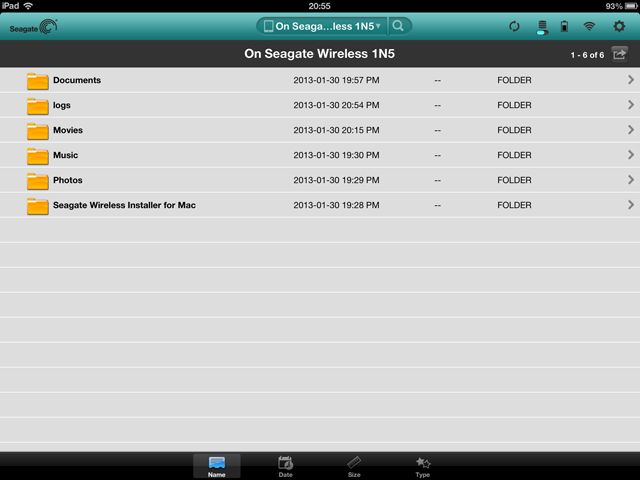
Seagate Media has a straightforward folders 'n' files view too
Seagate supplies a USB 3.0 cable - and a separate USB lead with a power pin on the end to charge the Wireless Plus’ battery. There’s a compact AC adaptor in the box too.
Battery life seems decent enough. Seagate claims it'll run for ten hours, but that's clearly with the caveat that this depends on how many client devices are wirelessly connected to the Plus and how far away from it they are. I saw nothing to suggest Seagate is significantly overestimating the battery life, which is reasonable for a gadget of this kind.
The on-board wireless adaptor only runs to 54Mb/s 802.11g, but it will tap into a local hotspot to provide connected iOS and Android devices with internet access as well as the contents of the drive. It’s not as fast as talking to a router directly with 802.11n, but it’s certainly usable. Seagate says eight devices can connect to the Wireless Plus for media access and eight more for internet access - it’s one or the other at the client not both. Devices without the Seagate Media app can access the Wireless Plus’ files through a browser.
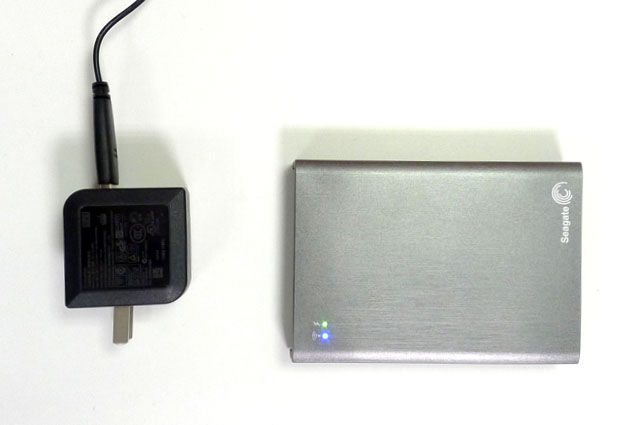
Seagate bundles a wee AC adaptor to top up the Wireless Plus' battery
Seagate says don't expect the Wireless Plus to host more than three simultaneous HD streams. I had no bother streaming two, either separate 1080p and a 720p videos, or the same 1080p footage sent to my two devices. While the Wireless Plus has no bother streaming, be prepared for a short wait while it gets the second stream cued up, or if you start jumping chapters in a streamed film.
Competition? There’s Kingston Technology’s WiDrive, of course, which is more compact because it’s Flash based. That makes it more expensive and the capacity peaks at 128GB - which will set you back around £120, £50 less than the Seagate product - until such time as Kingston decides to re-release it with an SD slot too. Even if it does, you’ll pay a pretty penny to get anywhere near the Wireless Plus’ 1TB.
The Reg Verdict
I found Seagate’s GoFlex Satellite and accompanying app to be a little to inflexible for my needs so when I upgraded my tablet, I bought one with a higher storage capacity. Had a I waited for the Wireless Plus, I could have stuck with a cheaper, lower-capacity slate and put the difference toward one of these boys. With its improved app and more broadly accessible storage - not to mention 1TB of space, twice as much as the GoFlex Satellite - this is a more sophisticated product than its predecessor. It’s a great way to keep your mobile devices - all your tablets and phones; we have six in our house and at least three are always taken on holiday - fed with content when you’re out and about. ®